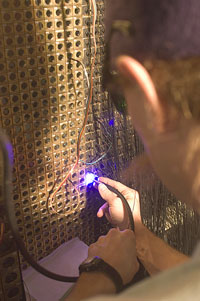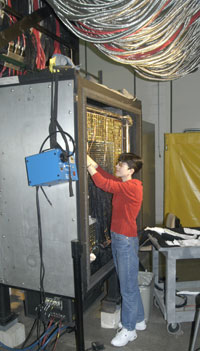2004 News Release
Big Experimental Equipment

Jarreas Underwood, Physics Division, uses an ultraviolet lamp to install the multichannel light monitoring system for HYCAL. Photo credit: Jefferson Lab
Hall B's PrimEx
The Primakoff Experiment (PrimEx) ran Sept. 27 - Nov. 24. The goal of the experiment was to obtain high precision measurements of the lifetime of the chargeless pion, or pi-0, particle. The more than 70 members of the PrimEx collaboration hope that this information will tell them more about symmetry in nature.
According to Dan Dale, PrimEx spokesperson and associate professor at the University of Kentucky, PrimEx scientists produced a pion by bombarding a nucleus with photons. The nucleus interacts with a photon by spitting out a photon of its own. "The nucleus always has a cloud of photons around it. We call this cloud the Coulomb field," Dale says. When the two photons collide, a chargeless pion is formed. The pion cruises along for about one attosecond before it decays back into two photons. The lifetime of a pion created by this simple process will be measured indirectly by measuring the energy and position of the two photons.
Dale says the researchers needed very precise measurements of these two photons. "And for that, we needed a big calorimeter with high resolution. The best options available for measuring these photons were newly developed detectors containing fast scintillator crystals made out of lead and tungsten," he says. Since these crystals were expensive, the collaboration built a hybrid calorimeter nicknamed HYCAL.
The central section of HYCAL used 1152 lead-tungstate scintillator crystal assemblies, while the outer part used a less expensive form of detector: 576 lead-glass cerenkov counters. The detector system was designed and built in just over three years, weighed in at about six tons and required nearly a million dollars to construct. A major research instrumentation grant from the National Science Foundation provided most of the funds for HYCAL.

University of Kentucky graduate student Marianna Gabrielyan works on HYCAL, the hybrid calorimeter built by the PrimEx collaboration. Photo credit: Jefferson Lab
"The most energetic photons should enter the detector closest to the beamline. These particles will enter the scintillator crystal detectors," Dale says. Once a photon enters a scintillator crystal, it's converted into a shower of particles which emit photons of visible light. These light photons are trapped in the crystal by a layer of reflecting material wrapped around each crystal and sealed with an ultrathin layer of Kevlar®. The light photons travel through the 18-centimeter long crystals into photomultiplier tubes. These photomultiplier tubes detect, amplify and transform the light photons into electrical pulses, which are then digitized and sent to the data acquisition system designed by the PrimEx collaboration.
Photons entering the 45-centimeter long lead-glass cylinders of the cerenkov detectors go through a similar process, though the principles of detecting particles with lead-glass are slightly different than those for lead tungstate. Photons entering the cerenkov detector modules generate showers of particles as they do in lead tungstate. The speed of light within the lead glass is slower than that in vacuum, and many of these shower particles are able to travel faster than light can travel in the lead glass. As a result, a flash of light is emitted. This so-called cerenkov light is detected in the photomultiplier tube at the end of the glass.
"From these measurements, we are getting the energy and position of each particle that enters the system. We can reconstruct the event, which gives us so-called invariant pion mass -- how heavy was that particle. And that way, we are actually detecting pi-0s through the photons they emit," explains PrimEx Spokesperson Ashot Gasparian, an associate professor at North Carolina A&T State University.
HYCAL collected data on pions that emerged from three different targets: carbon, lead and tin. The researchers are now analyzing the data they collected in preparation of sharing the results.
Look for expanded versions of each of these three stories in upcoming editions of Jefferson Lab's On Target Newsletter.
Thomas Jefferson National Accelerator Facility’s (Jefferson Lab’s) basic mission is to provide forefront scientific facilities, opportunities and leadership essential for discovering the fundamental structure of nuclear matter; to partner in industry to apply its advanced technology; and to serve the nation and its communities through education and public outreach. Jefferson Lab is a Department of Energy Office of Science research facility managed by the Southeastern Universities Research Association.

